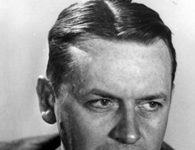Charlie Chaplin is one of the most familiar faces of the silent film era. With his expressive demeanor and comedic wit, this pioneering actor built a legacy that has lasted for decades.
Charlie Chaplin’s Early Days
Charles Spencer Chaplin was born April 16, 1889, in London, England. His father was a vocalist and actor, and his mother, whose stage name was Lily Harley, was a singer and actress.
Chaplin spent his early life living in an orphanage, state poorhouses and other poor rooms. At the age of 5 he was already on the stage. By age 10, he and a brother were left to fend for themselves after their father died and their mother developed an illness. They capitalized on the talents passed on to them by their parents and considered the theater a good career opportunity.
Charlie built a reputation as an excellent tap dancer in The Eight Lancashire Lads group. The poverty of his youth became a quality Chaplin would draw on to create the “Tramp” character that popularized his film career.
Sources in this Story
- Charlie Chaplin Official Website: Biography
- Time: Comedian: Charlie Chaplin
- The Kennedy Center ArtsEdge: This Week in the Arts
- The Museum of Modern Art: Charlie Chaplin
- The BBC: 1978: Charlie Chaplin’s stolen body found
Chaplin’s Notable Accomplishments
A mixture of “extraordinary athleticism, expressive grace, impeccable timing, endless inventiveness” and a willingness to work gave Chaplin the edge he needed to see his career take off, write Ann Douglas in Time.
In 1912, Mack Sennet signed Chaplin to Keystone Studios. He completed 35 films at Keystone, and then transferred to Essanay Studios, where he received an exceptional $10,000 signing bonus.
Chaplin’s reputation continued to build from his early years. In 1916, he received a $150,000 signing bonus for joining Mutual. He became the first actor to earn a $1 million fee in 1917. A national “Chaplinitis” followed, coming with songs, dances, dolls and comic books commemorating the actor.
For more than a decade, Chaplin opposed talking films like “The Jazz Singer.” “The Great Dictator,” Chaplin’s first talkie, hit the screens in the 1940s. “The Gold Rush” was Chaplin’s last silent film before the “talkie” movies began eclipsing the older medium. His role in this film departed from what he had done in the past, dealing with darker subjects like cannibalism and murder. Still, the film went on to become his most famous.
Among his many achievements, Chaplin, with Mary Pickford, Douglas Fairbanks and David Wark Griffith, founded United Artists Studios. He received two honorary Oscars, along with an Oscar for “Best Music, Original Dramatic Score,” for the 1952 film “Limelight.”
The Man and His Work
- “Charlie Chaplin 3 Disc Collector’s Edition (DVD)”
- “Chaplin Mutual Comedies: Restored 90th Anniversary Edition (1916)”
- “The Essential Chaplin: Perspectives on the Life and Art of the Great Comedian,” by Richard Schickel
The Rest of the Story
Chaplin lived through several dramatic twists in his private life. He was the subject of considerable FBI scrutiny over whether he had ever belonged to the Communist Party. He also had a few romantic entanglements, marrying three times, twice to girls who were 16. His third wife, Oona O’Neill, was 18 when they married. A public, drawn-out paternity suit in 1943 eventually led to a boycott of his films.
Chaplin was 88 years old when he died on Christmas Day in 1977. The following year, his grave, located near the Chaplin home in Corsier, Switzerland, was robbed. His body and casket were missing for 11 weeks until they were found on May 17.
When the Chaplins began receiving ransom demands for the return of Charlie’s body, police tapped their home and many other phone kiosks. Their efforts led to the arrest of two men, who confessed to stealing and reburying the actor’s body. Chaplin’s widow, Lady Oona Chaplin, had said she wouldn’t pay, noting, “Charlie would have thought it ridiculous.”
This article was originally written by Lindsey Chapman, it was updated March 9, 2017.











